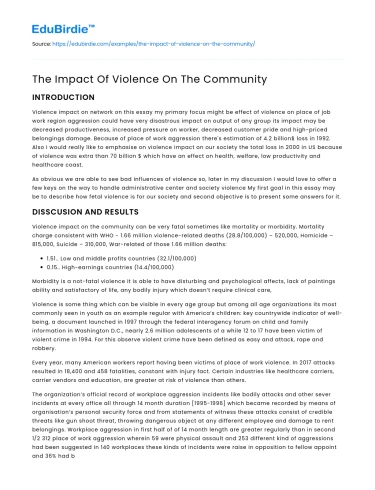Introduction
Violence within communities is a pervasive issue that transcends geographical, cultural, and socio-economic boundaries. While the immediate physical impact of violence is evident, its broader societal consequences are profound and far-reaching. This essay aims to explore the multifaceted impacts of violence on communities, delving into the psychological, economic, and social repercussions. By examining real-life examples and scholarly research, we will understand how violence not only disrupts individual lives but also imperils the fabric of society as a whole. Furthermore, this discussion will address potential counter-arguments, providing a balanced view of the complex dynamics at play. Ultimately, this analysis seeks to shed light on the urgent need for comprehensive strategies to mitigate violence and foster healthier, more resilient communities.
Psychological Impact on Community Members
The psychological ramifications of violence within communities are both immediate and long-lasting. Exposure to violence can lead to various mental health issues, including post-traumatic stress disorder (PTSD), anxiety, and depression. These conditions are not limited to direct victims but extend to witnesses and even entire neighborhoods. A study by the American Psychological Association found that children exposed to community violence are more likely to exhibit aggressive behavior and have difficulties in school, thereby perpetuating a cycle of violence and educational disadvantage (APA, 2020).
Moreover, the constant threat of violence creates a pervasive sense of fear and insecurity that can stifle community cohesion and engagement. Residents may become reluctant to participate in communal activities or even to leave their homes, leading to social isolation. This isolation further exacerbates mental health issues, creating a vicious cycle that is difficult to break. The sense of community trust is eroded, as residents may become suspicious of one another or the local authorities tasked with their protection.
Counter-arguments suggest that some communities develop resilience in the face of adversity, finding strength and solidarity in shared experiences. While this may be true in some cases, the overall psychological burden of living in a violent environment cannot be underestimated. The resilience argument should not overshadow the need for proactive measures to address the root causes of violence and provide adequate mental health support to affected individuals.
Economic Consequences of Community Violence
Violence within communities also incurs significant economic costs, affecting both individuals and the broader economy. Direct costs include medical expenses and property damage, while indirect costs encompass lost productivity, reduced property values, and decreased business investments. The Centers for Disease Control and Prevention (CDC) estimates that the cost of violence in the United States exceeds $100 billion annually, a staggering figure that underscores the economic burden of this issue (CDC, 2019).
Businesses in violent neighborhoods may face challenges such as theft, vandalism, and a diminished customer base, leading to reduced profits or even closure. This, in turn, results in job losses and decreased economic opportunities for residents. Moreover, property values in high-crime areas tend to be lower, affecting homeowners' ability to build wealth and invest in their communities. The economic instability perpetuated by violence can lead to a downward spiral of poverty and crime, further entrenching socio-economic disparities.
While some argue that increased law enforcement presence can mitigate these economic impacts, this approach often fails to address the underlying social determinants of violence, such as poverty and lack of access to education and healthcare. A more holistic approach that combines economic development initiatives with community-based violence prevention programs is essential to breaking this cycle and promoting sustainable economic growth.
Social and Cultural Implications
Beyond psychological and economic impacts, violence profoundly affects the social and cultural fabric of communities. Social structures become destabilized as family units are disrupted, and traditional community roles are altered. High levels of violence can lead to a breakdown in social norms, resulting in a culture where violence is normalized and perpetuated across generations.
Community violence can also exacerbate social divisions, contributing to racial and socio-economic tensions. For instance, marginalized communities often face disproportionate levels of violence, leading to a cycle of victimization and mistrust towards institutions. This is particularly evident in urban areas where racial disparities in violence are most pronounced. As scholar Michelle Alexander notes, "The racial dimension of mass incarceration and its impact on communities of color cannot be ignored" (Alexander, 2010).
Efforts to address community violence must therefore incorporate strategies to bridge social divides and foster inclusivity. Cultural programs that celebrate diversity and promote understanding can play a crucial role in healing fractured communities and building social capital. Additionally, involving community members in violence prevention initiatives can empower residents to take ownership of their neighborhoods and work collaboratively towards lasting change.
Conclusion
In conclusion, the impact of violence on communities is a multi-dimensional issue that demands comprehensive and collaborative solutions. The psychological, economic, and social repercussions of violence extend beyond immediate victims, affecting the overall well-being and resilience of entire communities. Addressing these challenges requires an integrated approach that combines mental health support, economic development, and community engagement. While counter-arguments highlight potential resilience in the face of adversity, the focus must remain on addressing the root causes of violence and fostering environments where communities can thrive. By adopting a holistic perspective and involving all stakeholders, we can work towards reducing violence and building stronger, more cohesive communities for future generations.






 Stuck on your essay?
Stuck on your essay?

